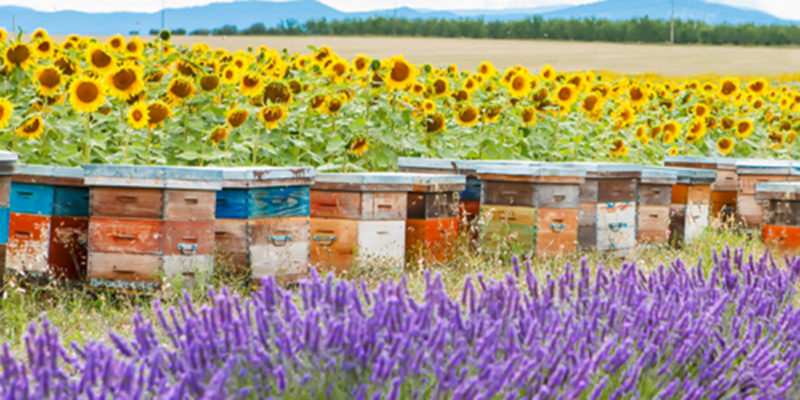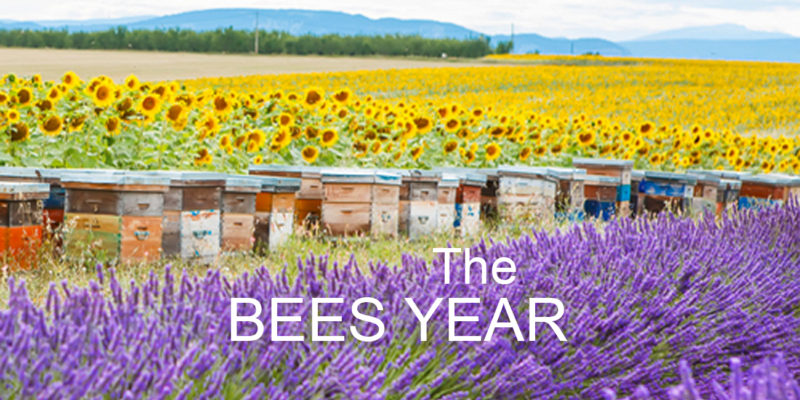The cycle of a bee year
March:
Rapid growth in the bee colony requires as many long-lived and fresh winter bees as possible. The best requirements for optimal development are plentiful food stocks thanks to carefully measured winter feeding, a high-quality and rich pollen intake, increasing daytime temperatures, and hygienic honeycomb construction with plenty of open cells for breeding. If there is a food shortage, feed combs or easy-intake feeding with ambrosia® bee feed syrup can help. In the spring, the bee colony wants to achieve harmonious and optimal growth at any cost. The goal is to avoid any disruptions during this time of year – every interference means the loss of a day’s development.
April:
During this time, food stocks diminish rapidly. Unfortunately, this cannot be measured in the weighing hive, since the increased brood weight and decreased food stock balance each other out. It is essential to do regular visual inspections until the fruit trees start to bloom so that any shortages can be counteracted right away. On the other hand, before intensive nectar flow and thus means honey production starts, filled food combs have to be removed. Otherwise, food can be transferred in the honeycombs and this means adulteration of honey. This is also the time to start reducing varroa mites by cutting out the drone brood, from now on regularly during the whole bee season.
May:
This month, if the beekeeper has done everything right, the bees will show what enormous feats they are capable of when they have been well cared for. The main focus is on directing their swarm instinct at the right time. Now is the time to create young colonies for the next season in order to ensure healthy, strong replacement potential. Continue cutting out the drone brood in order to keep varroa mites from spreading.
June:
When removing the last honey from the early yield, leave generous honey reserves for the colony in order to avoid shortfalls in the event of a nectar gap. If the honey yield runs dry, you will need to provide weekly doses of 2,5-kg packages of ambrosia® bee feed fondant within four or five days to bridge the gap. It is important to prevent any contamination of the honey. To ensure that no feed gets into the next honey, only honey should be fed, if necessary, but only honey from your own beekeeping.
July:
The bee year is now past its peak, and the colony is starting to slowly prepare for the winter. There are still quite a few bees, but the honey yield is dwindling. After the last honey extraction in the middle of the month, you should start feeding ambrosia® bee feed fondant rightaway (we recommend the 15 kg package) in order to make sure the bees keep caring for the brood and there is no risk of robbing. It will take them about 14 days to intake the feed. The fondant will keep the bees occupied, which distracts them from chasing away the summer bees that are no longer needed. By processing the fondant, the summer bees are still encouraged to gather pollen and collect water, which helps keep the population healthy and protects the winter bees that are so important for the future of the colony. That in turn promotes their overwintering and next springtime development. With the end of the honey harvest comes the time for infestation checks and corresponding varroa treatments.
August:
This is when the consistent cutting out of the drone brood pays off. Beekeepers who have taken the entire capped brood out of the population fare even better. If you have done everything right, the varroa mite infestation should be low (fewer than 1-2 mites per day), and your bees will be healthier and more vital. Nurse bees that are healthy and well fed can raise winter bees with good fat- and protein-bodies. The process of shrinking the population down to its ideal winter size is continuing, and the colony will drop to 10 – 12 thousand bees by the end of October, or 9 – 10 occupied honeycombs. Weaker colonies with fewer than 5,000 bees (4 honeycombs DN, Zander) should be united; you do not need to look for queens.
September:
If the food supply (for two-room hibernation) is still less than 20 kg, it can be secured by providing ambrosia® bee feed syrup. For one-room hibernation, feed 1 litre of syrup per standard-sized honeycomb. Toward the end of the month and into October, the last winter bees will emerge. During their limited foraging trips, they need to find fresh pollen to create the necessary fat- and protein-body. Winter bees should not be caring for the brood anymore, since that would significantly shorten their life spans. Colonies that continue to care for the brood come weaker from the winter or rarely will not survive the period between hibernation and fruit-tree blossoming.
In addition, you should always confirm the proper dosage when using medications after the last honey harvest. By ensuring plentiful food during the non-yield period and during winter feeding, you create an important basis for a healthy, vital bee colony – which guarantees successful honey harvests in the next year.
The wide variety of ambrosia® products gives beekeepers bee feed options that are critical for success, easy to use and cost-effective, leaving them more time for other important beekeeping tasks. A solid understanding of the connections between the bee colony and external influencing factors is becoming more and more important. This guide aims to help with that.
10 important things to know about the start of the bee year
- The end of the honey yield season (mid-July in most regions) and the last summer honey harvest mark the start of the new bee year – the bee colony needs to build up its winter food stocks. ambrosia® bee feed syrup and ambrosia®bee feed fondant are especially well suited for this. Their high efficiency and good digestibility help maintain high-quality breeding activity.
- A varroa infestation check and reduction of the mite population must take place based on the recommendations of the Working Group of German Bee Institutes. Control the treatment success and watch for possible mite reinvasions.
- Summer bees should still be collecting, preparing and storing food.
- When the general supply of pollen and ambrosia® bee feed is good, the larvae should be swimming in enough larval jelly.
- Starting in September, it is no longer possible to expand the brood nest through feeding.
- The winter bees still need to be able to build up an optimal fat- and protein-body.
- Winter bees begin to age as soon as brood activities or other glandular activities such as food preparation start taking place.
- Delay the winter bees’ aging process with a brooding break that is as long as possible. Therefor let the colony hibernate on an open grate bottom.
- Check consumption rates by weighing the hives. Even late in the year, a food shortage can be supplemented using ambrosia® bee feed syrup. Its good intake and inversion are perfectly tailored to the needs of the bees.
- The winter food supply for a strong and healthy bee colony should be no less than 15 – 20 kg in early October, depending on the size of the colony.
We gladly answer your questions and recommend a specialized local retailer.


